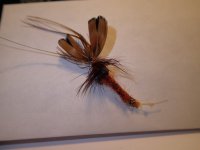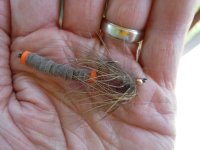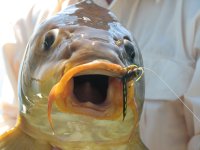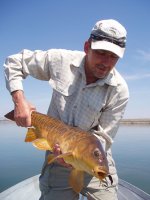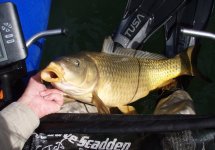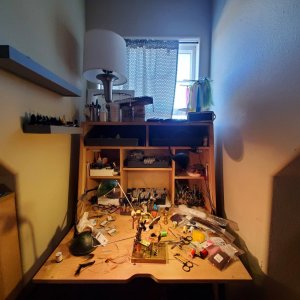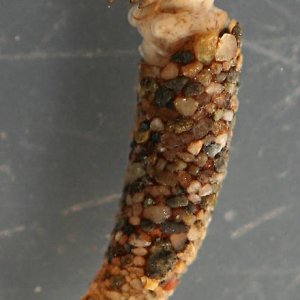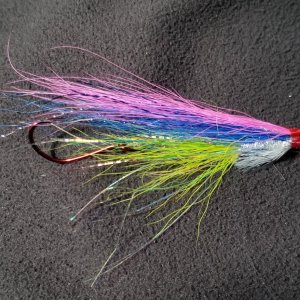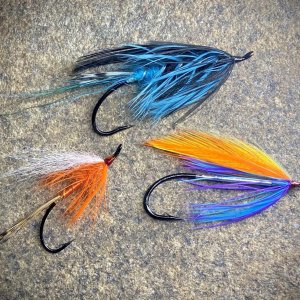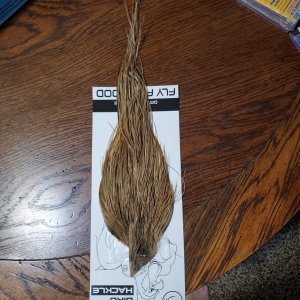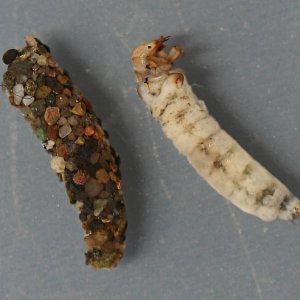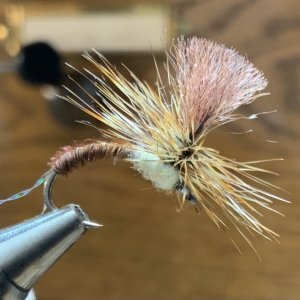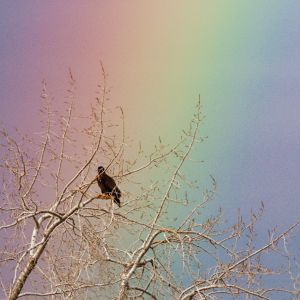I hadn't responded because I'm not qualified for "pro tips" and I didn't see this until about 8:30 last night, that's bedtime. ;-)
- Summer time on the flats are great - where do they go the rest of the year? Are they accessible the rest of the year?
Great questions and my answer is I don't know the answer to either one. I had a theory, since disproven, that carp basically hibernate as the waters get very cold but then one year I was fishing Potholes for perch (the lake was ice free that winter) when my ultralight spinning rod bent double and that perch started peeling line. It was a carp. I think that was a RARE encounter. But then this winter,
@RichS caught a monster.
@Billy tells me he's seen some carp in some of his secret waters. I do believe, without a shred of proof, that carp seek a thermocline and become mostly dormant. Finding them in the winter will prove tough on my side of the Cascades in stillwaters since most years we have ice covering the lakes. A good place to hunt for them might be Winchester Wasteway (oh no, hot spot); you'll need a boat and a way to get that boat back upstream in skinny water.
- What's their spawn timing? How does that change how you approach them from an angling perspective?
Thanks
@Bruce Baker - usually the water is too cold over here for the carp to begin spawning in April but then there's some really skinny, muddy water along one large reservoir that gets muddier sooner than most. I often see spawning behavior in these shallow ponds much earlier than most parts of the Columbia and other waters. Usually by July 4th, the spawn is mostly done and post spawn fish can be hungry. When carp are in spawn mode, it's a really tough game but sometimes you'll find a few lone food hunters. Maybe it's a female that has already broadcast her spawn? Maybe it's a carp that see's a meal and eats but in my experience when carp are in full spawn, the males are truly interested in bumping the female they're following to get her to release some eggs. Those boys have one thing and one thing only on their minds.
* Is fly selection purely mojo based? Or are certain conditions and/or behavior an indicator for fly selection?
I started fishing for carp in 1996 or so with basically a half dozen flies in a bag, they were all size 6 woolly worms (wooly worms?), mostly black with webby grizzly hackle, no red tag, not orange hotspot, weighted with .020 or .025 fuse wire. That simple fly worked time and time again. Over time came experimenting - now I have three fly boxes bulging with carp treats. One of my go to favorites is a crayfish pattern, and I tie that fly in multiple colors and sizes; sometimes you would ask - Buzzy, is that a crayfish or what the heck?
View attachment 53743
This crayfish works well, sometimes.
As I'm fishing a shoreline, I change flies depending on bottom structure. Nosing my boat along a muddy section of bottom, I won't fish a crayfish as I don't associate muddy bottoms with crayfish (yes, I know they're also known as mudbugs) as the fly just doesn't seem to work (at least for me) on muddy bottom water, but that old wooly worm does (sometimes).
I forget how many years ago I heard about Jon Luke's "carp candy" pattern. This fly was a real game changer for me and probably was the catalyst to experiment with patterns. I found a decal of a carp on an ecology block near one of my carp flats. Someone on the other forum was able to identify the culprit who put his "sticker" (sounds like PNWFF kind of behavior, eh?) there and in searching, found the gent and was able to glean some of his techniques and flies.
I can't remember who first started talking about the "trouser worm" - but I've built a few of these patterns. They're fun to fish and I plan to experiment with them some more this coming year: the floating tail (thanks to
@Jim F. for giving me the right tool to punch out the cylinders). The Trouser Worm:
View attachment 53748
Four or five years ago I got the idea to try fishing flies under a bobber.
@Engee and I were out early (pre-spawn), the water was cold, we were wadered up. I had a small size 12 bead head jig (olive with a hot spot and pine squirrel tail) suspended a couple feet below an Airlok bobber. Two trout ate, a couple carp and two bass. I've never been able to duplicate that feat bit have, from time to time, fooled a fish or two. I really gave up on it last year but it could be something to try in really off colored water (mud).
- What do you look for when you're looking for 'carp water' (assuming shallow flats with deep water nearby)....
When fishing from a boat I don't mind fishing water that deeper than I can wade. One meandering stream that opens up into lakes here and there, can fish really well in water up to four or five feet deep. Obviously that's boat fishin' - (I'm still angry that I sold my tin boat last year). This is a two or three person outing with one person poling and one person on the bow. The water has to be relatively clear so the anglers and poler can see the fish or at lease see the poof as a carp roots around. This is GREAT Jon Luke Carp Candy or
@Engee's black Crayfish pattern water.
When wade stalking carp, I don't like to fish water much deeper than my knee caps - for me, if th water is much deeper than that, I just can't see the fish as well.
I was fishing the Columbia River between Wanapum State Park and the I-90 bridge (oh - hot spot) one year with a buddy, we had a banner day and decided to go back the next day. Someone at Wanapum or the dams above lost the message that we were going fishing, the reservoir was down maybe three feet? Our carp flat was high and dry. There was a "new" island out in the middle of the river..... things change and that can be very frustrating or it can be very exciting with new water.
- Is there certain carp behaviors that completely dictate how you approach them?
Rarely are carp not skittish and easily spooked. So being quiet, stealthy, invisible is essential. If your in a boat and that guy on the back with the pole bangs the boat with the pole just as Engee is casting to a fish, that fish will be gone. When wading, slow and quiet, minimizing your splashing and wakes certainly helps your chances of catching a feeding fish.
Feeding fish - that's what I'm looking for. Carp with their snouts down in the mud, sand, gravel or even rock. Cruisers? Rarely, in my experience, are cruisers fish that will eat yet I almost always cast to cruisers because you know, sometimes one will break away and follow a fly. Rooters are your best option. And the best of the best is that rooter that's facing away from you so you can get even closer: for this rooter, make your cast beyond where the fish is stirring up the botton and strip your fly towards the fish. If the bottom is sandy gravel, you should be able to see the fish turn and suck in the fly: MAN, that's the best. If the water is really dirty, you may not be able to see anyting more than a poof and the fishes tail. Try the same thing, drag the fly towards the fish and look for a change in the orientation of the fishes tail. Timing on this particular take, if the tail changes direction, set quickly.
It seems like 90% of the carp I fish for are slowly swiming (hunters not cruisers) are coming towards me and most of the time they see me as I see them, that's usually game over. But if you spot a hunting carp coming towards you, cast well ahead of the path the fish is on and wait for him to come close, the twitch the fly. Often I get hung up on the bottom so this is where that trouser worm pattern with the floating tail shines with fewer bottom foulings.
Carp on the Fly (Reynolds, Befus and Berryman) is a great resource.
View attachment 53749
Carp Candy
View attachment 53750

